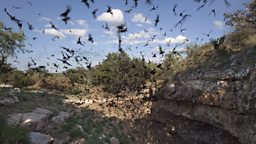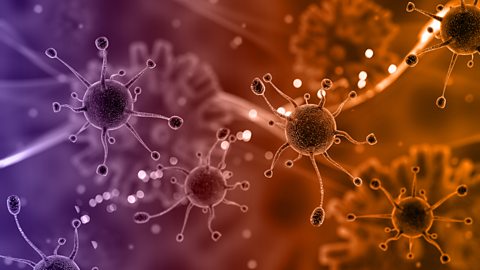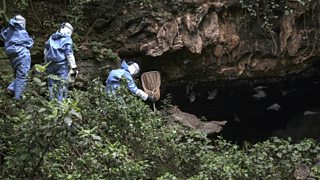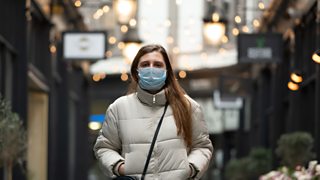The Virus Hunters: heroes racing to extinguish new pathogens
SARS-CoV-2 is the virus responsible for the pandemic that has currently changed life as we know it.
But there are millions of other viruses living around the world, any one of which could mutate and infect us at any time.
In The Virus Hunters, Oxford professor Trudie Lang hears from the scientists in a never-ending race to identify these pathogens and contain their dangerous effects.

Who are the virus hunters?
Today, the entire world is caught up in the quest to combat the latest virus, which has crossed the species barrier into humans. It’s a situation that unfolded with startling speed, but was not necessarily a surprise.

In the last 30 years, more than 50 novel viruses have leaped from animals to humans: Ebola, swine flu, bird flu, Zika and dengue – to name just a few. Severe Acute Respiratory Syndrome, or SARS (first identified in 2002) is thought to have passed from bats, possibly via civet cats. Evidence so far is that MERS, Middle Eastern Respiratory Syndrome, moves between humans and camels. We’re not sure where COVID-19 started, but evidence is pointing to bats and possibly pangolins.
This viral transfer between species and then jumping into humans is called zoonosis. Zoonosis is a common but complex event, and it’s difficult to work out how it happens. But there are scientists working hard to identify these jumps and help prevent deadly consequences – the virus hunters.
“The virus hunters, the epidemiologists, the threat detectives – we’ve been going after these zoonotic diseases, these diseases of animals that come to humans, for a long time,” says Larry Brilliant, an epidemiologist who was part of the team that hunted the smallpox virus to extinction in the late 1970s. “It’s not just that they jump from animals to humans at the rate of one to three every year, it’s that there are thousands of them that have not yet made that jump.”
Virus hunting in the field

Virus hunters are working in some of the world’s most challenging settings, often putting themselves dangerously close to parasites that most of us would run to avoid…
In many places around the globe, close proximity to animals is part of life. In rural Cambodia, for instance, families set up large canopies around their homes where bats can roost. They then collect the nutrient rich bat guano (excrement) to sell as fertiliser. It presents a great risk, as it makes it easier for circulating viruses to be transmitted. Working with these local communities – teaching them how diseases are transmitted and ways to do things differently, so everyone is kept safe – is crucial.
Tracey Goldstein is the Professor of Pathology, Microbiology and Immunology at the University of California, Davis. She’s also one of the principal investigators for the PREDICT project. Their goal is to strengthen global capacity for the detection and discovery of viruses with pandemic potential.
“We do a tonne of community engagement,” says Tracey. They have teams on the ground who get to know the village people – from elders to children. And they host meetings explaining what they’re doing, why and how their scientists will be dressed.
How a virus works

Could a virus improve your health?
Martha Clokie on how a virus can destroy a bacteria that attacks our bodies.
“The other important thing is to go back and report results,” she says. With one campaign – “Living Safely with Bats” – they collated a picture book documenting these results. They explained to residents how to recognise signs of bats in their home, when food or water might have been shared with bats, and how to protect their children and animals, to limit exposure.
The big question with COVID-19 is how did that spill-over happen?Dibesh Karmacharya
“We are continually trying to be out there, sampling animals and people to have an idea of what’s circulating,” says Tracey. “I think we definitely are an early warning system.”
Fighting pathogens in the lab
In laboratories around the world, the detailed work of understanding viruses is taking place.
Dibesh Karmacharya is Executive Director at the Centre for Molecular Dynamics in Kathmandu. His lab is working on disease surveillance with the PREDICT project. “There are millions and millions of viruses… and in our understanding I think we know less than five percent of them,” says the epidemiologist. In eight years of research, they discovered about 119 different viruses. Some of them were very unique and were found for the first time in Nepal.
“In Nepal we’re engaged in finding emerging diseases in communities that are of high risk,” says Dibesh. Cities like Kathmandu are densely populated and full of wildlife that’s intermingling with the local population, making it a very “high risk” site for emerging diseases. They have found coronaviruses in rats, ducks and humans from the same area.
“The big question with COVID-19 is how did that spill-over happen? Where did that come from? What changed in the viral genome that made them transmissible from person to person and ultimately made it a pandemic?” These are all questions that virus hunters like Dibesh are working hard to answer.
Looking for a vaccine

One lesson we’ve learned from COVID-19 is that we need to collaborate to tackle these viruses, and be ready for the next one. A full variety of public health scientists working together is essential if we’re to treat, manage and ultimately prevent these viruses infecting huge swathes of our population.
A key part of the collaborative response to the current pandemic is going to be a vaccination programme. But we can’t vaccinate ourselves against another coronavirus – the common cold – so will we be able to vaccinate against COVID-19?
Professor Susan Weiss is a virologist at the University of Pennsylvania. She suggests the reason we haven’t got a vaccine for the common cold might be that we haven’t tried that hard, because the illness is so mild. “This virus obviously is so much more lethal that there’s a lot more motivation to find a vaccine or antivirals,” says Susan. If we could find an inhibitor to one of these proteins that’s common to all coronaviruses, we’d have an antivirus that would probably work on the common cold too.
Developing vaccines is difficult and costly. It requires large scale trials across varying populations to see if it works and, crucially, is safe. And if it’s to be used globally it needs to be practical and affordable everywhere. Success in finding a vaccine for this pandemic is more likely if there’s global collaboration and, currently, there are around a hundred projects around the world looking for a solution.
Using technology
Jimmy Whitworth is a Professor of International Public Health at the London School of Hygiene and Tropical Medicine, and he’s been a virus hunter for a long time. The first epidemic he was involved with was in the Gambia in 1983. There was a cluster of cases of anthrax, which had crossed over from livestock. Back then, if Jimmy wanted to communicate with the UK it was either wait two weeks for a letter to get there and a reply to arrive, or drive five hours to the nearest telephone exchange. But that’s all changed. “Now, in your pocket, you’ve got a way of either phoning or emailing immediately and getting a response,” says Jimmy.
Viruses that cause pandemics are like rivers. They reshape national boundaries. They have historically changed the way countries act.Dr. Larry Brilliant
Technology will also be crucial for stopping the spread of the virus, before a vaccine is found. Spatial epidemiology is the theory behind many of the sophisticated and sometimes controversial contact tracing apps which track and isolate cases of COVID-19. Being able to utilise data like this is going to be big part of the effort to slow transmission. In the absence of a vaccine, it will be a key tool for preventing new infections as communities come out of lockdown. It also means we can be more specific about where we target interventions and direct resources.
Keeping the world safe
Hunting the viruses that pose a significant threat to our health takes a whole team of researchers – in the field sampling people and animals, peering down microscopes, exploring data, and running mathematical models. And without these virus hunters, the world would be a much more hazardous place.
“Viruses that cause pandemics are like rivers,” says Larry Brilliant. “They reshape national boundaries. They have historically changed the way countries act. They change customs. They effect every aspect of human life. And we need these virus hunters, these threat detectives, these gum shoe epidemiologists, to track it down, all over the world, and figure out ways to stop it.”
-
![]()
The Virus Hunters
There are millions of viruses living around the world. Professor Trudie Lang hears from the virus hunters who work against the clock to understand and extinguish new pathogens.

-
![]()
Coronavirus
The facts and the context behind the COVID-19 from Radio 4.
-
![]()
More or Less
Comparing countries, the risk to NHS staff, and birdsong.
-
![]()
China and the virus
Has the Covid-19 epidemic weakened or strengthened the grip of China’s Communist Party?
-
![]()
The Briefing Room – Coronavirus: What next?
How close to a vaccine are we? David Aaronovitch looks at how the science is progressing.





